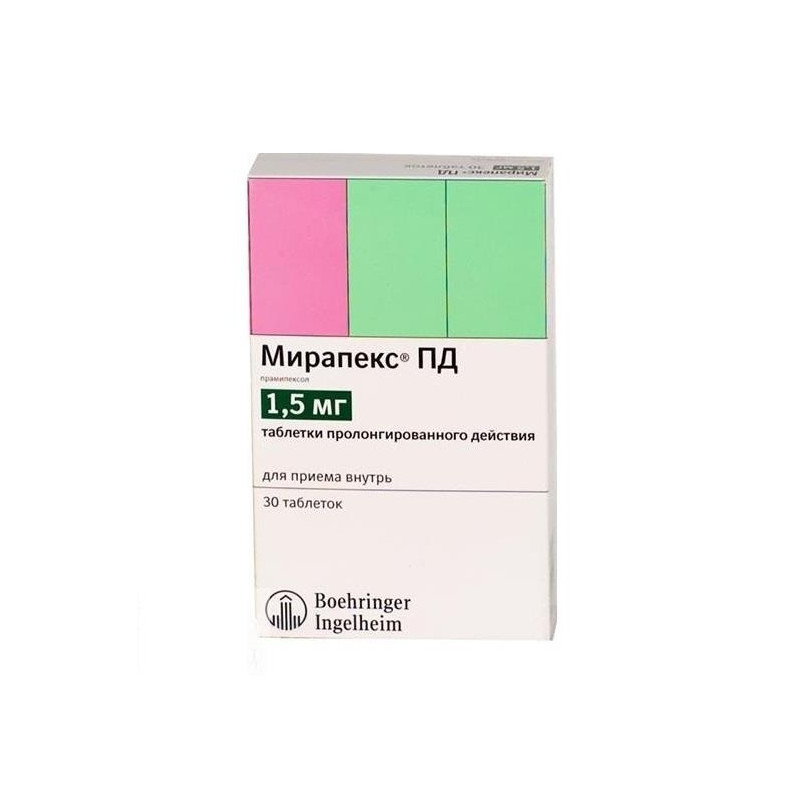



 All payments are encrypted via SSL
All payments are encrypted via SSL
 Full Refund if you haven't received your order
Full Refund if you haven't received your order
Extended Release Tablets
1 pill contains pramipexole (as monohydrate dichloride) 1.5 mg
30 pieces
Mirapex PD has a dopaminergic effect. Excites D2 dopamine receptors, incl. striatum.
Parkinson's disease.
Hypersensitivity.
In pregnancy, only if the benefit to the mother outweighs the potential risk to the fetus. At the time of treatment should stop breastfeeding.
Mirapex PD take inside. The initial dose at any stage of Parkinson's disease - 0.375 mg / day in 3 doses, if necessary, may increase, but not more often than every 5-7 days according to the scheme: on the 1st day - by 0.375 mg / day, from the 2nd on the 7th - 0.75 mg / day; maintenance dose - 1.5-4.5 mg / day in 3 doses.
Nervous system: drowsiness, dyskinesias, hallucinations; in some cases - insomnia. With the rapid reduction of the dose of pramipexol, as well as with the abrupt cancellation of the drug, a neuroleptic malignant syndrome was observed.
Gastrointestinal: nausea, constipation.
Cardiovascular: in some cases, at the beginning of treatment - arterial hypotension (especially with a gradual increase in dose for too short a time).
Other: in some cases, peripheral edema.
During treatment with pramipexol, episodes of sudden falling asleep were noted against the background of daytime wakefulness. Drowsiness usually develops with the use of Mirapex in doses of more than 1.5 mg / day. Episodes of sudden falling asleep against the background of daytime wakefulness occur against the background of an already developed drowsiness. Factors that increase the risk of drowsiness include the simultaneous use of sedatives, sleep disorders, the simultaneous use of drugs that increase the level of pramipexole in the blood plasma (for example, cimetidine). Before prescribing Mirapex, the physician should determine the presence of these risk factors. During therapy, it is necessary to monitor the patient's condition to identify the propensity for drowsiness. With the development of severe daytime sleepiness or the appearance of episodes of sudden sleep on the background of daytime wakefulness, which require active intervention, Mirapex should be canceled. If it is necessary to continue therapy, the dose of the drug should be reduced and the patient should be advised to refrain from driving and other potentially dangerous activities.
During the treatment with Mirapex, the incidence of arterial hypotension, as a rule, did not increase compared with placebo.
Elderly patients (65 years and older) require dose adjustment of Mirapex.
Since pramipexol is eliminated by the kidneys, patients with kidney disease may need a dose adjustment.
Influence on ability to drive motor transport and control mechanisms
The patient should refrain from driving and other potentially dangerous activities until the nature of the drug’s effect on the ability to concentrate and the speed of psychomotor reactions is established.
Use in pediatrics
Safety and effectiveness of Mirapex in children has not been established.
With the simultaneous use of Mirapex and levodopa may develop dyskinesia (in such cases, the dose of levodopa should be reduced).
There is no pharmacokinetic interaction between pramipexol and selegiline.
With simultaneous use with cimetidine, an increase in plasma concentration of pramipexole is noted. Other drugs that are secreted by the organic cation transport system in the kidney can also contribute to an increase in plasma concentration of pramipexole.
Symptoms: not installed. Clinical experience with a significant overdose of Mirapex is absent. One patient with a 10-year history of schizophrenia took 11 mg / day of pramipexole for 2 days; this is 2-3 times more than the daily dose recommended by the protocol. No adverse effects were noted due to an increase in dose.Blood pressure remained stable, although the heart rate increased to 100-120 beats / min.
Treatment: antidote pramipexole is unknown. When symptoms of CNS stimulation appear, neuroleptics can be used - derivatives of phenothiazine or butyrophenone, but the effectiveness of these drugs in eliminating the effects of Mirapex overdose has not been evaluated. In the treatment of overdose may require maintenance therapy, gastric lavage, the use of means for rehydration and detoxification of the body, ECG monitoring.
The drug should be stored in a dark place at a temperature of 25 ° C (fluctuations from 15 ° to 30 ° C are permissible).
Mirapex front